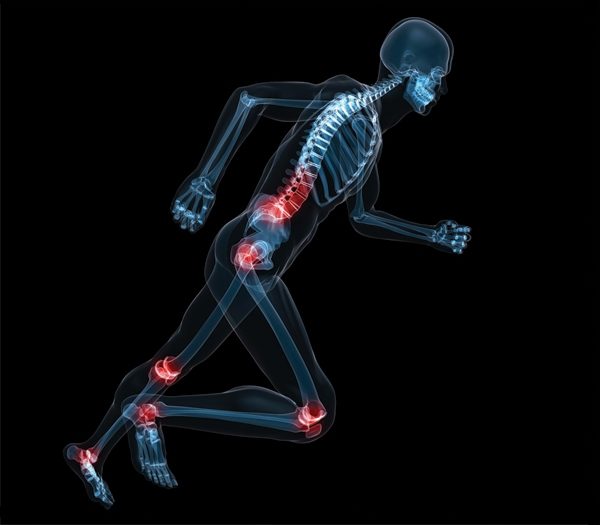The bone and joint health arena is ripe for drawing analogies. For example: it’s not about which tools are in the toolkit, but how you use them. Or: You need a whole orchestra to create a symphony. Further relevance can be found in the idiom: “The early bird gets the worm.” In this context, the prevention-minded supplement-taker gets healthy bones for a lifetime, or can keep the worst of arthritis symptoms from setting in, as the case may be.
There are also many missteps (some potentially dangerous) to avoid in addressing these areas with supplements. It will also behoove a retailer to understand just who can benefit from these products. Though bone support supplements are rightfully associated with use by women, men should not neglect the category; likewise, though joint discomfort due to aging is historically the focus, youth with active lifestyles should not miss the benefits that both supplementation and topical agents can bring to joint health.
Bone Up on Bone Support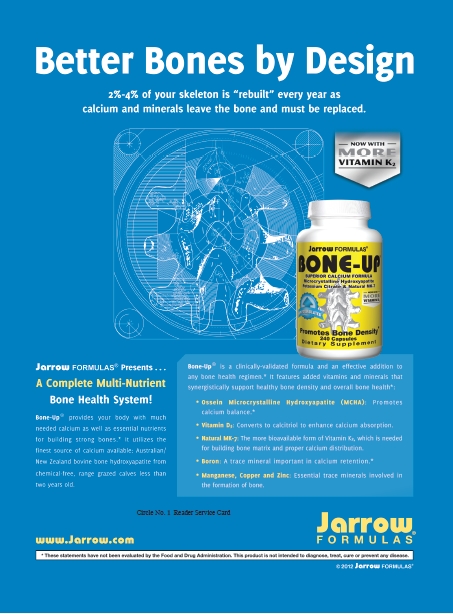
Bones are not just comprised of hard, inert matter, though it may appear that way from gazing at a lifeless skeleton hanging in an anatomy classroom. Understanding the complex vitality of the skeletal system is a step toward keeping bones healthy. “The first thing to remember is that bone is a vibrant, living tissue. Too often we think of it as a static mineral structure and nothing more,” says Cheryl Myers, chief of scientific affairs and education at EuroPharma, Inc., Green Bay, WI. Bone is intimately and inextricably involved, she explains, with the mineral balance in the body. The exchange of minerals, as some are released by bones into the bloodstream and others are utilized to build new bone tissue, is more or less constant.
It is when an interruption in that balance occurs that problems start. “Since bone is a living tissue and part of the interconnected web that makes up our physical bodies, it is subject to many of the same stressors, such as chronic inflammation and high homocysteine,” says Myers.
One thing to take important note of before discussing supplementation is the common problem pH balance can pose for bone density, as described by Lou Paradise, president and chief of research for Topical BioMedics, Inc., Rhinebeck, NY. He claims that many people suffer from metabolic acidosis, meaning that an excess of acid in the bloodstream is compromising the alkaline setting necessary for healthy bones. “The consumption of excess refined sugar, refined white flour, sodas and excess animal protein all contribute to this. The body will use alkaline minerals from the bones to counteract the acidity, and losing bone mass is the result,” says Paradise.
The remedy is consuming more alkalizing fruits and vegetables, while reducing the afore-mentioned acidifying dietary intakes. “Supplementing can then be beneficial and provide additional support for healthy joint and bone health, once we address the metabolic issue first,” he says.
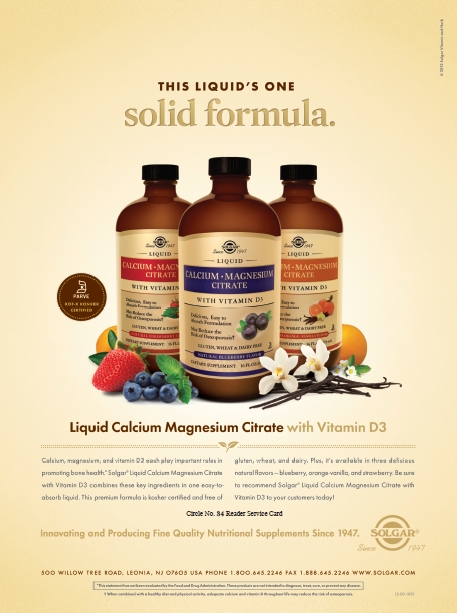 Supplemental calcium intake has some attendant issues that will be addressed later. But certainly, the bone health category revolves around this mineral, due to its central function in the bone-building process. There are many other nutrients, however, that play a supporting role in the formation and maintenance of bone tissue. Dallas Clouatre, Ph.D., R&D consultant for Jarrow Formulas, Los Angeles, CA, cites the trace mineral boron for its role in estrogen metabolism, since the hormone is in turn related to bone density. “Potassium has been shown to reduce calcium loss from the body. Magnesium helps to keep calcium in the bones, where it belongs, rather than in the lining of the arteries, where it does not. Zinc stimulates bone formation and reduces bone resorption,” says Clouatre. Resorption is the process by which osteoclasts break down and release the minerals found in bone into the bloodstream (1).
Supplemental calcium intake has some attendant issues that will be addressed later. But certainly, the bone health category revolves around this mineral, due to its central function in the bone-building process. There are many other nutrients, however, that play a supporting role in the formation and maintenance of bone tissue. Dallas Clouatre, Ph.D., R&D consultant for Jarrow Formulas, Los Angeles, CA, cites the trace mineral boron for its role in estrogen metabolism, since the hormone is in turn related to bone density. “Potassium has been shown to reduce calcium loss from the body. Magnesium helps to keep calcium in the bones, where it belongs, rather than in the lining of the arteries, where it does not. Zinc stimulates bone formation and reduces bone resorption,” says Clouatre. Resorption is the process by which osteoclasts break down and release the minerals found in bone into the bloodstream (1).
Magnesium plays a balancing role with regard to calcium, but research finds it is important for bone health in its own right. One study that found improved bone mineral density (BMD) from increased magnesium intake attributed these results to several potential factors: magnesium improving vitamin D synthesis, the high alkalinity of a diet high in magnesium and/or the substitution of magnesium for calcium in bone formation, making for more structurally sound bones (2).
Vitamin K, Clouatre continues, helps to maintain lumbar bone and reduce new fractures. Folic acid (vitamin B3) can reduce the bloodstream presence of homocysteine, high levels of which have been connected to osteoporosis. As many know, vitamin D is associated with the absorption of calcium from the gut and maintaining calcium levels in bones. “Vitamin C, copper, manganese and glucosamine are all important for supporting the activities of the bone matrix, the most active site of bone repair,” he concludes. Vitamin C plays an often unheralded role in bone health. According to information provided by American Health, Ronkonkoma, NY, vitamin C is vital to the production of collagen, which as we’ll hear comprises the essential protein portion of strong, tough bones.
Ron Udell, president and CEO, OptiPure/Kenko International, Inc., Los Angeles, CA highlights the effect that a branded squid cartilage extract (IncaCartilago from OptiPure) can have on bone density. “IncaCartilago is made from the Humboldt, a Peruvian squid, and concentrated in a unique extraction method in Japan,” says Udell. The specific benefits associated with the proprietary extract derive from its chondroitin content.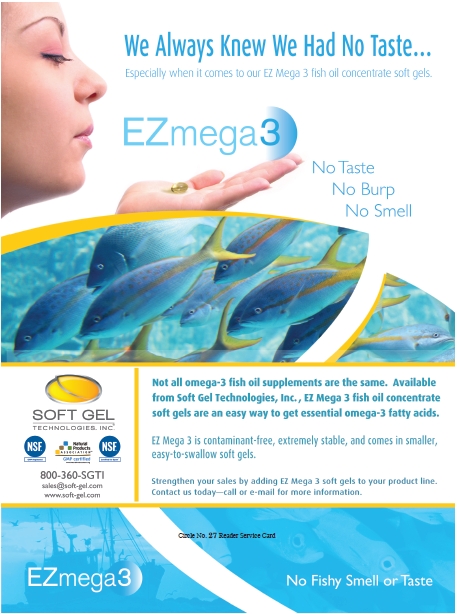
While chondroitin sulfate types A and C are present in the ingredient, it is the more rarely encountered chondroitin sulfate E that is thought to result in stronger bones. The distinction between chondroitin sulfate types is made based upon the site of sulfation. Chondroitin E derived from Humboldt squid, for example, undergoes sulfation at carbons 4 and 6 of the glucuronic acid-acetylgalactosamine component, and is referred to as “oversulfated” chondroitin. “A and C have been the key constituents in other forms of chondroitin, be it bovine, porcine, shark or others. This one is unique in that it enhances bone density as well,” Udell says.
Aside from the well-recognized joint health effects of chondroitin, this ingredient has been found to improve the reproduction of osteoblasts, and to aid the production of bone morphogenetic protein (BMP), osteocalcin (a protein found in bones) and collagen. The enhanced BMP production has been linked in a study to the remineralization of bone (3). Collagen, meanwhile, accounts for the majority of bone’s mass, and lends bones their strength and toughness, as others will later attest.
The prevalent condition of chronic tissue inflammation can indirectly create issues for both bone and joint health. The cause of this condition is often dietary. “In addition to a diet containing too many omega-6 fatty acids, a shortage of nutritional antioxidants, such as vitamin E, contributes to chronic inflammation,” Steve Holtby, president and CEO of Soft Gel Technologies, Inc., Los Angeles, CA, says.
Underlying inflammation is an all-too-common thread for those with bone and joint issues, explains Keri Marshall M.S., N.D., chief medical officer of Nordic Naturals, Watsonville, CA. “As a result, the first thing any consumer should reach for is something to combat inflammation,” she says, adding that fish oil quickly comes to mind for its well-researched anti-inflammatory benefits.
Ingestion of omega-3s, primarily EPA and DHA, leads to the creation of anti-inflammatory molecules such as prostaglandins 1 and 3. These can reduce pain and swelling as well as relax muscle spasms, Marshall explains, stating, “You can take all the supplements in the world, but if you do not correct the underlying inflammatory component, you will continue to chase symptoms.” She also cites recent research findings that link fish consumption to improved bone health and less bone loss (3).
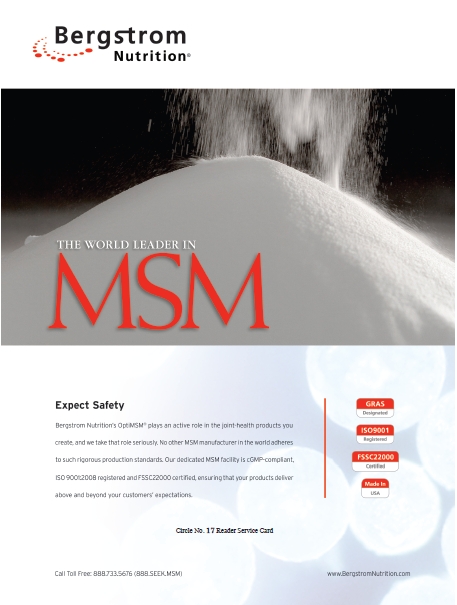 Horsetail, says Myers, standardized for silica content and stripped of abrasive substances, can help increase the absorption of calcium into the bone. In at least one product, marine oil is added to better facilitate that absorption. “It doesn’t matter how many minerals one takes—what matters is what one absorbs,” she says.
Horsetail, says Myers, standardized for silica content and stripped of abrasive substances, can help increase the absorption of calcium into the bone. In at least one product, marine oil is added to better facilitate that absorption. “It doesn’t matter how many minerals one takes—what matters is what one absorbs,” she says.
Indeed, many other nutrients and branded ingredients benefit bone health, but the key component among all is proper use. For starters, the form of calcium being ingested is an important consideration. “Older customers that are more likely to take calcium supplements also tend to have diminishing stomach acid available for digesting calcium from food and other non-chelated (predigested) sources,” says Neil E. Levin, CCN, DANLA, nutrition education manager for NOW Foods, Bloomingdale, IL. Therefore, these individuals may better absorb calcium in chelated forms, including citrate, malate, ascorbate or when bonded to certain amino acids.
One promising nutrient that comes with a cautionary note is strontium. “There are excellent studies using strontium to rebuild bones, but strontium should never be a part of a bone formula because it competes with calcium for absorption,” says Myers. Her company sells it separately from products that contain calcium for this reason. Since minerals in general can be met with absorption difficulties, she also highlights the importance of amino acid chelates as an option.
“In general, bone and joint supplements can be taken with meals and are best spread out during the day to maximize absorption,” says Levin. He specifically adds that fat-soluble nutrients like vitamins A, D, E and K, as well as CoQ10, lutein, lycopene, ALA and others should ideally be consumed alongside fat-containing meals. Another usage tip from Levin is that taking calcium and/or magnesium in the evening may aid some individuals in relaxing and going to sleep.
A final note to keep in mind regarding the concepts of bone health and osteoporosis is that other important factors are in play besides bone-supportive nutrition. While osteoporosis prevention is necessary, says Michael Murray, N.D., director of product development and education for Natural Factors, Everett, WA, an awareness of sarcopenia should also be encouraged. “Sarcopenia is the loss of skeletal muscle mass and strength as we age. Sarcopenia is to our muscle mass what osteoporosis is to our bones,” he says. The degree to which this condition worsens as we age is a predictor of 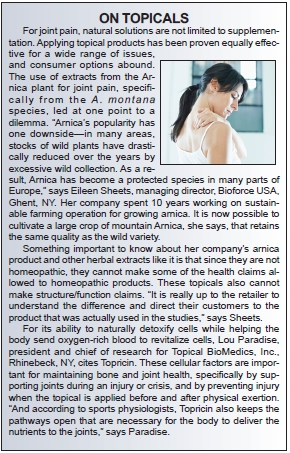 mortality and disability, Murray notes, and it is linked with increased falls and bone fractures.
mortality and disability, Murray notes, and it is linked with increased falls and bone fractures.
The Calcium Conundrum
If calcium can be described as the center of the bone health universe, the question still remains as to whether everything revolves around it. Most current views on bone formation concur that there is more to consider than calcium, and too much attention paid to it to the neglect of other nutrients is done so at one’s own risk. “If calcium alone was the answer, over the better part 40 years, we would have seen a huge reduction if not the elimination of osteoporosis and brittle bones as a significant issue,” says Ken Whitman, president of Natural Vitality, Austin, TX.
One approach to this idea, that calcium needs help if bones are to remain healthy, lies in the role other nutrients play in allowing calcium to do its job. “Calcium should be taken concurrently with other supplements that enhance its bioavailability, such as vitamin D or magnesium. Vitamin K2-7 has also been shown to promote the body’s utilization of calcium,” says Rodney Benjamin, technical director for Bergstrom Nutrition, Vancouver, WA.
The relationship between calcium and magnesium gets plenty of attention, but Whitman worries that people aren’t coming close to an ideal balance. “Beginning with a 2:1 calcium to magnesium ratio is already imbalanced, especially when 70–80% of people don’t get their minimum daily requirement of magnesium,” he says. There is also the potential to overburden the body with calcium, to the detriment of healthy bone formation.
Says Carolyn Dean, M.D., N.D., medical director of the Nutritional Magnesium Association, “Use of calcium with vitamin D to enhance calcium absorption without a balancing amount of magnesium causes further magnesium deficiency, which triggers a cascade of events leading to bone loss.” A 32-page guide to the benefits of magnesium, along with symptoms of magnesium deficiency, is available as a free download at www.nutritionalmagnesium.org.
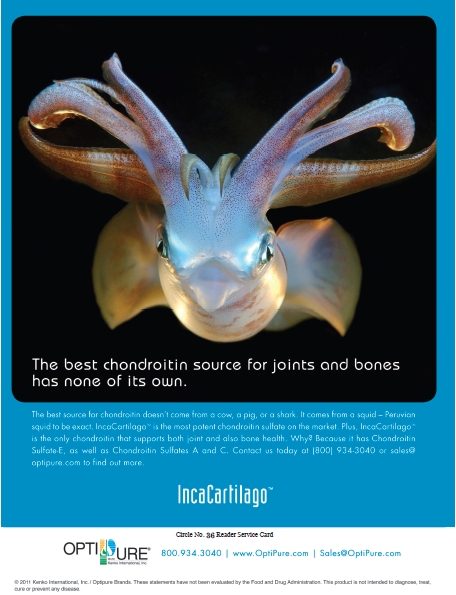 Striking the right balance here is something many bone health formulas do well. “The key to maximizing these preventive benefits is to make sure that your supplement uses a good bioavailable calcium, along with adequate magnesium, and the right form of vitamin D,” says Kevin J. Ruff, Ph.D., MBA, director of scientific and regulatory affairs for Membrell, Carthage, MO. This potent combination is well-established, according to Ruff, to reduce osteoporosis risk in adults, and in women in particular.
Striking the right balance here is something many bone health formulas do well. “The key to maximizing these preventive benefits is to make sure that your supplement uses a good bioavailable calcium, along with adequate magnesium, and the right form of vitamin D,” says Kevin J. Ruff, Ph.D., MBA, director of scientific and regulatory affairs for Membrell, Carthage, MO. This potent combination is well-established, according to Ruff, to reduce osteoporosis risk in adults, and in women in particular.
To gain a visual understanding of how an imbalance between calcium and magnesium can occur, Dean suggests an in-home experiment: “Crush a calcium pill and see how much dissolves in 1 oz of water. Then, crush a magnesium pill and slowly stir it into the calcium water. When you introduce the magnesium, the remaining calcium dissolves; it becomes more water-soluble. The same thing happens in your bloodstream, heart, brain, kidneys and all the other tissues in your body.”
Meanwhile, if avoiding catastrophic hip fractures and other bone breakages is the desired endpoint of supplementation, then consumers would do well to heed this recent finding: “Calcium supplementation, alone or with vitamin D, may stabilize bone mineral density to some small degree, but this does not improve fracture risk,” says Clouatre, referring to a recent study in the American Journal of Clinical Nutrition (4).
A supplement option called bone-derived hydroxyapatite, according to Clouatre, can allow for a steady flow of calcium into the bloodstream, rather than induce calcium spikes like traditional calcium. “Of further interest is the fact that bone-derived hydroxyapatite brings with it magnesium and other minerals found naturally in living bone,” he says.
Be ever mindful. Bone and joint care is a difficult task, in that it must be addressed both for the long-term and over a long period of time; meanwhile, the events consumers are trying to avoid can be sudden and debilitating. It therefore helps to be aware of as many risks as possible. For one thing, there is an association, according to Murray, between extended use of proton-pump acid blocking drugs and an increased risk of hip fractures.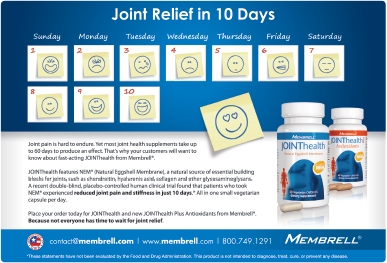
“In addition, while current drug therapy increases bone mineral density, it does not improve bone quality or ‘toughness’—chalk is denser than bamboo, but bamboo is tougher and less likely to break,” he says. Improving the quality of new bone formation and of the collagen matrix behind the process is likely to be more critical to bone toughness than the mineral content of bone, Murray believes. To illustrate, he claims that only about 15–30% of hip fractures in postmenopausal women are accounted for by osteoporosis, and that one-third of all women that experience a hip fracture have normal bone density.
There is also the potential to falsely attribute certain symptoms to bone and joint health, according to Murray. “The most important point I can make about bone and joint issues is that a solid diagnosis is always required, especially in cases of arthritis.” In his practice, one 55-year-old woman came in presenting hip pain that had lasted a year. She arrived with a diagnosis of osteoarthritis from a family doctor, without an x-ray having been taken. Ibuprofen and other drugs did not lessen the pain, and neither did acupuncture or glucosamine sulfate. An x-ray revealed that the pain was being caused by the spread of breast cancer to her hip bone.
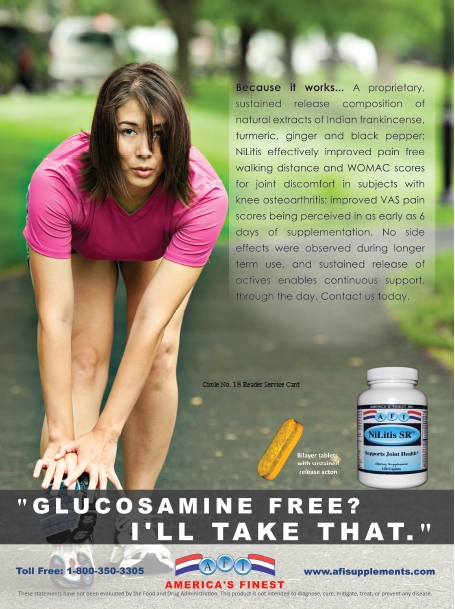 Are You Dense?
Are You Dense?
The traditional approach of allopathic medicine to fostering bone health is to reduce the activity of osteoclasts, Clouatre explains. This has the unfortunate effect of not only preventing bone loss, but disallowing the renewal of bone. This results in the appearance of microfactures and other compositional changes that weaken bones. “This was seen in animal experiments after three to four years of use and it now is known to happen in humans, as well. Bone ‘quantity’ is preserved at the expense of bone ‘quality,’” says Clouatre.
This is why building BMD with the full natural toolkit for strong, lasting bones is essential. To begin with, Ruff points to the evidence that calcium derived from eggshells can improve BMD in osteoporosis sufferers, and in healthy postmenopausal women, too. But to completely support bone health, it may be necessary to look at the importance of protein. “While minerals like calcium get all of the attention in preventing osteoporosis, it is important to realize that osteoporosis involves both the mineral (inorganic) and nonmineral (organic matrix) components of bone. The organic matrix is composed primarily of collagen protein,” says Murray.
One critical nutrient to support the collagen matrix is silicon. “During bone growth and the early phases of bone calcification, silicon has an essential role in the formation of cross-links between collagen and proteoglycans,” Murray says. He cites research into a branded silicon supplement (BioSil from Natural Factors) showing that compared to a control group receiving calcium and vitamin D, those taking 6 mg of silicon saw a 22% increase in the collagen content of their bones, and a 2% increase in BMD within a year of use. This method of BMD improvement produces greater tensile strength and flexibility in bones, according to Murray.
Clouatre also notes that it’s the quality of bone repair that matters, not just how much repairing is accomplished. He delves into vitamin K’s ability to aid in this process. The vitamin K family of vitamins are fat-soluble, and are needed for the modification of proteins involved in blood coagulation, as well as proteins that aid calcium chelation for use in bone and other tissues, he explains.
This cofactor function can specifically be  found in vitamin K’s activation of matrix gla protein (MGP), thought to control the calcification process. MGP is also linked to the inhibition of unwanted calcification in cardiovascular tissue. “Evidence shows that calcium alone, or in any other combination without vitamin K-2 menaquinone-7, can go rogue,” says Paula Nurnberger, marketing manager for P.L. Thomas, Morristown, NJ, referring to a reduction in these cardiovascular issues associated with this form of the vitamin. It also activates osteocalcin, or bone gla protein, a non-collagen protein abundant in bone. Low vitamin K levels, in general, have been associated with reduced BMD and heightened fracture risk.
found in vitamin K’s activation of matrix gla protein (MGP), thought to control the calcification process. MGP is also linked to the inhibition of unwanted calcification in cardiovascular tissue. “Evidence shows that calcium alone, or in any other combination without vitamin K-2 menaquinone-7, can go rogue,” says Paula Nurnberger, marketing manager for P.L. Thomas, Morristown, NJ, referring to a reduction in these cardiovascular issues associated with this form of the vitamin. It also activates osteocalcin, or bone gla protein, a non-collagen protein abundant in bone. Low vitamin K levels, in general, have been associated with reduced BMD and heightened fracture risk.
This attempt at increasing density through supplementation can obviously vary in its success rate and in terms of the timeframe in which to expect change. Michael Jeffers, president of Helios Corp., Santa Fe, NM, puts the time needed for any biochemical reactions to begin at two to three weeks, and the actual bone development process at three to four months. He describes the process by which his company analyzes the progress of its branded ingredient in forming bone, saying, “When our clinical patients take NC-518, we utilize dexascan evaluations at the beginning of consumption and then at the end of the fourth month of consumption of NC-518, or the timeframe that the Surgeon General’s office might suggest an increase in bone density would occur.”
Within this framework, Jeffers reports a 2.2% increase in bone density within four months with 800 mg/day of the ingredient. “We [began] a Phase III human clinical in January with 80 participants and expect to fully duplicate our Phase II results,” he says. The average age in this ongoing trial is 45–70, and includes both men and women. Researchers will conduct a full-body dexascan at the outset, and at six and 12 months. They will also test blood serum markers of bone health at the same intervals to gain insight into the effects on inner and outer bone health.
However consumers decide to approach the process of properly supporting bone density, Paradise believes they should start it early, particularly women. “In addition, women should seek more education in understanding metabolic issues and deficiencies and the role of hormones in this and other health issues, and how to use supplements to maintain healthy hormone balance,” he says.
 Feeling Dis-jointed?
Feeling Dis-jointed?
Moving from the bones themselves to what’s in between them, we arrive at the joint care side of things, where there is much to cover. Levin divides the space neatly into joint structural support products and joint pain and mobility products. He says that this conveys to the customer the importance of having both bases covered. For example, one should not neglect the long-term benefits of glucosamine in keeping joints from eroding, while one is seeking temporary relief from minor aches and pains.
Though achy joints are as old as time, there is plenty of room to improve upon how we care for them. Nurnberger tells us where the advancements are being made. “Innovation continues to lie in how to deliver nutrition/nutraceuticals in the body to stimulate synovial fluid production and cartilage regeneration. This lies in tandem with continued efforts to improve bio-assimilation,” she says.
Though inflammation has been discussed in connection with bone formation and is important in that context, it is perhaps more crucial to understand the part it plays in joint issues. Non-steroidal anti-inflammatory drugs like ibuprofen and aspirin may temporarily relieve symptoms. But, explains Holtby, by shutting down the activity of the COX-2 enzyme, these drugs are theorized to also suppress the production of the blood-clotting horomone prostacyclin and other enzymes important for cardiovascular health. On the supplement side of things, “Scientists have discovered many herbs that can safely, powerfully, and naturally inhibit the COX-2 enzyme, including hops.”
A proprietary hops extract was found comparable to ibuprofen in reducing pain-causing biochemicals, according to Dean Mosca, president of Proprietary Nutritionals Inc., Kearny, NJ. “A second clinical study of patients with knee pain showed Perluxan had a fast-acting effect on relieving discomfort and significant improvement over placebo after only two hours following the first dose,” says Mosca.
The active component of the spice turmeric is a leading candidate when combating inflammation. “Curcumin has been touted as the ‘most anti-inflammatory herb on the planet,’ and there appears to be a certain amount of scientific truth to that claim,” says Myers. It possesses activity against several inflammatory pathways, including COX-2, LOX, TNF-alpha, IFN-gamma, and NF-kappaB, she explains.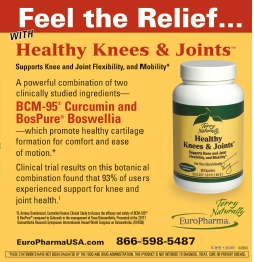
Curcumin may face some absorption issues, with large amounts needing to be ingested for bloodstream levels to rise. A patented methodology for formulating curcumin (BCM-95, U.S. distribution by EuroPharma) has been successful in safely improving absorption, by utilizing micronized curcumin along with essential oils from turmeric to boost bioavailability.
Murray describes the mechanism of action of another joint supplement, which involves cutting off a portion of the inflammatory process at the cellular level. During inflammation, the junctions between vascular cells that line the joints increase in size and allow white blood cells to enter into the joint space. Inside, the white blood cells are responsible for further inflammation and damage to the joint. This product works by tightening up these cellular junctions, according to Murray, noting, “In a randomized, double-blind, placebo-controlled study, MicroLactin had a significantly better effect in improving joint health versus placebo than did glucosamine supplements alone.”
Asked about which natural joint health supplements retailers should be better educated, Benjamin brought up methylsulfonylmethane (MSM). “Many retailers could benefit from increasing their knowledge of MSM. MSM is one of the ‘Big 3’ for joint health along with glucosamine and chondroitin.” Though perhaps not as well known as the other two, he says that MSM has the edge of benefiting other conditions besides joint health, such as seasonal immune health and allergies, liver support and for strengthening skin, hair and nails.
Chondroitin continues to be a mainstay in the joint health category. Further validation of its benefits was found in a study cited by Udell, on the squid extract ingredient IncaCartilago previously described in the context of bone density. This chondroitin sulfate E ingredient was found to bind selectively to midkines, which are proteins that are involved in the development of inflammatory conditions like arthritis. The binding of chondroitin sulfate E to midkines inhibits their ability to induce inflamed cells to migrate to other areas (6).
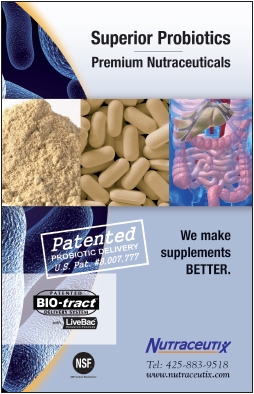 A branded eggshell membrane supplement (NEM from ESM Technologies) has studied benefits for those with joint issues. “NEM was shown to be effective at relieving joint pain and stiffness in as few as seven to 10 days with just one 500 mg capsule per day,” says Ruff (5). Preliminary research has tied these benefits to its ability to regulate markers of inflammation. “NEM was shown to significantly reduce a number of pro-inflammatory cytokines, especially cytokines interferon-gamma and tumor necrosis factor-alpha,” says Micah Osborne, president of Membrell.
A branded eggshell membrane supplement (NEM from ESM Technologies) has studied benefits for those with joint issues. “NEM was shown to be effective at relieving joint pain and stiffness in as few as seven to 10 days with just one 500 mg capsule per day,” says Ruff (5). Preliminary research has tied these benefits to its ability to regulate markers of inflammation. “NEM was shown to significantly reduce a number of pro-inflammatory cytokines, especially cytokines interferon-gamma and tumor necrosis factor-alpha,” says Micah Osborne, president of Membrell.
One joint health creatine ingredient called Kre-Alkalyn can reduce cell damage and cut down on the inflammatory response after exercise, according to Joe Archer, vice president of sales and marketing at All American Pharmaceutical, Billings, MT. One patented use of the ingredient involves bonding it with esterified fatty acid carbons. This process makes the fatty acids stable, so they do not react with oxygen. “Inflammation can shorten our lifespan by promoting many degenerative diseases, so the benefits of Kre-Celazine are essential in reducing this risk,” Archer says.
Homeopathic joint care products also make up a portion of the market worth being knowledgeable about. Says Kristy Anderson, NMD, consultant to Heel, Inc., Albuquerque, NM, “Effective and safe homeopathic medicines can be taken to address joint pain and stiffness without the unwanted side effects or drug interactions that may be found with over-the-counter pain medications.”
Compared with one non-steroidal anti-inflammatory drug, one homeopathic remedy (Zeel from Heel) was found equally effective at reducing pain and improving flexibility, without gastrointestinal and other side effects, according to Anderson. Herbs including Rhus toxicodendron, Arnica montana, Sanguinaria canadensis and Natrum oxalaceticum are found in the formula.
Collagen also makes a return to relevance in the context of joints. Paul Dijkstra, CEO of InterHealth Nutraceuticals, Benicia, CA, points to the patented UC-II, a type 2 collagen (responsible for cartilage) for its support of already damaged joints. “Importantly, instead of simply patching the damage, UC-II helps stop the destructive cycle of cartilage erosion and repairs joints,” he says.
A randomized double-blind research study into the ingredient found that 40 mg/day increased joint comfort, flexibility and mobility, according to Dijkstra. A further finding was that it provided more of these benefits than a 2,700-mg combination of glucosamine and chondroitin. The ingredient improved pain levels during daily activities such as walking on a flat service, ascending stairs and resting in bed.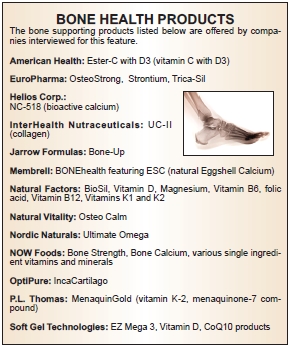
To the joint health parade, Clouatre adds the intriguing potential of boswellia extract products to produce joint benefits as the category is further developed and refined.
“Historically, joint health supplements have primarily been utilized by an aging demographic to help minimize arthritic pain,” Benjamin says of the category in general. He describes this as unfortunate, since studies show that joint health supplements can help prevent the break-downs associated with joint issues. “For instance, two separate studies have shown that MSM reduces expression of inflammatory cytokines that degrade articular cartilage, which can lead to osteoarthritis,” he says. This suggests a need for active individuals to understand the need for prevention, Benjamin says, instead of waiting until it “hurts” to address the issue. Because whether we like it or not, the bones and joints of young people, male and female, one day turn into the diminished bones and joints of aging individuals.
We’ve All Got ‘Em
Everyone who wants to stand and move, let alone run, jump, dance, etc., needs a complementary set of bones and joints to get the job done. Keeping them in good shape is the tricky part. “Intense exercise causes inflammation to the muscles. Too much training and too little rest can produce excessive amounts of inflammation that leads to tissue deterioration, impaired immunity and serious overtraining,” says Archer.
Young and restless. Those that exercise intensely like this, and younger people with active lifestyles in general, should be made aware of the need to protect themselves from damage. “Joint health is a concern for everyone because it directly impacts mobility and therefore overall quality of life. We might think of seniors first, but young athletes and moderately active adults have an interest in maintaining joint health as well,” says Bergstrom Nutrition’s marketing director, Holly Harmon.
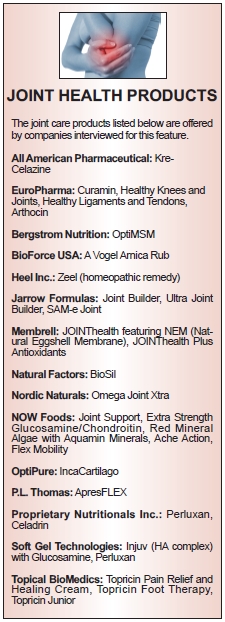 Some products are well suited to prevention-minded consumers, with results often being achieved through cartilage protection. Eileen Sheets, managing director of Bioforce USA, Ghent, NY, touts the benefits of applying Arnica gel (extracted from A. Montana), a direct herbal option for topically addressing joint pain (see sidebar on p. 22 for more on topicals). “Although this is a product that appeals to those with age related joint discomforts, athletes have also discovered the benefits,” she says.
Some products are well suited to prevention-minded consumers, with results often being achieved through cartilage protection. Eileen Sheets, managing director of Bioforce USA, Ghent, NY, touts the benefits of applying Arnica gel (extracted from A. Montana), a direct herbal option for topically addressing joint pain (see sidebar on p. 22 for more on topicals). “Although this is a product that appeals to those with age related joint discomforts, athletes have also discovered the benefits,” she says.
Marshall believes fish oil is an important supplement to prevent inflammation, and to support a quicker recovery for joints after workouts: “Any person who is active is at risk of developing joint aches and pains, and that can include young and college-aged athletes, middle-aged people trying to maintain a healthy workout schedule, and certainly the weekend warrior who only has time for one or two intense workouts from time to time” will benefit, she says.
With or without intensive exercise, gradual degradation of joints over time is natural. But, this doesn’t mean people should give up on the prospect of retaining joint health throughout their lives. “You can't strengthen joints, but you can, through diet, dietary supplements and lifestyle modifications, slow down the rate of natural degradation,” says Mosca.
Men, too? If women are rightly encouraged to look after their bone health, it remains to be discussed whether men should leave well enough alone, or should take precautionary measures as well. “Because of their larger body and bone size, men generally do not experience accelerated bone thinning at the same age as women (the year before and first three years after menopause), and it often manifests itself in the sixth or seventh decade of life,” says Myers. She notes, however, that with average life expectancy increasing, most men will arrive at an age where they’ll experience some bone fragility, and could therefore benefit from supplementation.
“A lot of the market is focused on women alone, which is an oversight as more and more men are developing weak bones due to poor diet and lack of supplementation of needed nutrients like calcium, vitamin D and vitamin K,” says Osborne. Nurnberger says it’s a natural process, just like with women: “Men do indeed lose bone mass as well, and can suffer fractures as they become elderly. We are big believers that bone support is a universal concern.” Others believe the focus is on women for a good reason. “80–90% of cases of osteoporosis occur in women; the cases that do happen in men are almost always secondary to a medical condition,” says Murray.
The issue may be, however, that those rare men who face serious bone risks overlook them because of a lack of awareness. Some believe this starts with consumers’ health care practitioners, not supplement marketers. “I don’t think the medical establishment places much emphasis on checking bone density for men in the same way that they have made it routine for women. The problem with awareness really starts there,” says Marshall.
A group in potential double-jeopardy when it comes to bone and joint health are vegetarians. Their options may be somewhat limited for dietary supplements appropriate to their diet, and they of all people may be more susceptible to the nutritional deficiencies that can affect things like bone formation. “Vegetarians enjoy getting the latest formulas and ingredients as much as anyone, but find that their choices are often limited by raw material sources, capsule sources, and other formulation ingredients and excipients,” says Levin. Animal-sourced ingredients, like vitamin D3 and chondroitin sulfate for example, are widespread in the market. But, Levin sees the general growth in the bone and joint categories boding well for the emergence of new vegetarian-friendly options. WF
References
1. “Bone Resorption,” WebMD, http://dictionary.webmd.com/terms/bone-resorption, accessed Dec. 29, 2011.
2. K.M. Ryder, et al., “Magnesium intake from food and supplements is associated with bone mineral density in healthy older white subjects,” Journal of the American Geriatrics Society 53(11), 1875-80 (2005).
3. T. mizayaki, et al., “Oversulfated Chondroitin Sulfate-E Binds to BMP-4 and Enhances Osteoblast Differentiation,” J. Cell. Physiol. 217(3) 769-777 (2008).
4. E.K. Farina, et al., “Protective effects of fish intake and interactive effects of long-chain polyunsaturated fatty acid intakes on hip bone mineral density in older adults: the Framingham Osteoporosis Study,” Am J Clin Nutr. 93(5), 1142-51 (2011).
5. M.J. Bolland, et al., “Calcium and vitamin D supplements and health outcomes: a reanalysis of the Women's Health Initiative (WHI) limited-access data set,” Am J Clin Nutr. 94(4), 1144-9 (2011).
6. H. Yamamoto, et al., “Midkine as a Molecular Target: Comparison of Effects of Chondroitin Sulfate E and siRNA,” Biochem. Biphys. Res. Commun. 351(4), 915-19 (2006).
7. K.J. Ruff, “Eggshell Membrane A Possible New Natural Therapeutic For Joint & Connective Tissue Disorders: Results From Two Open-Label Human Clinical Studies,” Clinical Interventions in Aging 4, 235-240 (2009).
Published in WholeFoods Magazine, February 2012

